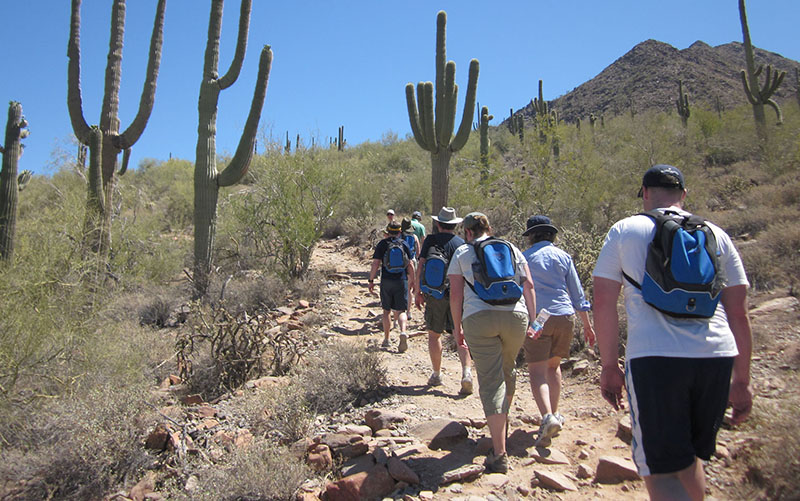
Arizona was among the top states for length of workout by users of a fitness app, a fact that experts credit to the state’s climate and the chance to get outdoors year-round for exercise. (Photo by Take a Hike Arizona via flickr/Creative Commons)
WASHINGTON – People in Arizona work out longer than those in almost any other state, according to an analysis of data from millions of users of a popular fitness app.
Arizona ranked fifth among states, with an average weekly workout of 79 minutes, said the analysis of data from the MapMyFitness app. California was first, at 87.4 minutes per week on average, followed by Colorado, Washington and Oregon.
Experts caution that the numbers don’t necessarily mean that Arizonans themselves are working out more – the app only records where a person works out at a given time, not where they live. But they also said that, current heat wave aside, the state’s standing makes sense given its climate for the rest of the year.
More of the outdoors
An analysis of data from the MapMyFitness app showed people in Arizona had among the highest weekly workout times in the nation. The top five states for average weekly total workout times were:
“It doesn’t surprise me,” said Sam McClung, president of the Southern Arizona Hiking Club. “Everyone’s active all year round, they don’t take any sort of break for the winter.”
He said he sees people in Arizona putting forth effort to get outside constantly, and his club plans hiking trips every week of the year. Summer heat just calls for earlier starts.
The analysis was done by UnderArmour, which owns the fitness app. It said 22 million people use the app, which lets users enter what type of exercise they’re doing and then tracks the time and location of that workout.
Arizona ranked 34th among states for duration of users’ runs, according to the data, but fourth for both walking and biking, to give the state a combined fifth-place finish.
That those three are outdoor activities is likely a factor in Arizona’s high rank, said Kristin Hoffner, a senior lecturer of kinesiology at Arizona State University.
“We do see correlations with things like nice weather, and a good environment to promote active behaviors,” Hoffner said.
She also noted that a gym workout can be intimidating to some people – but everybody knows how to walk.
“Thus, the outdoor exercise appeals to many more people that the gym may not,” Hoffner said.
Aside from the obvious draw of weather, local government officials said many Arizona cities also have developed trail systems that contribute to people wanting to get outside to exercise.
“I think we take the trails here very seriously, too,” said Joe Daynes, recreation services director for the city of Prescott. “People are really taking advantage of that right now.”
Daynes said the attraction makes sense.
“If you can get a good workout and be surrounded by Mother Nature at the same time I think you have a pretty good deal,” he said.
But Lawrence Frank, a professor of public health at the University of British Columbia, cautioned against taking data from a set of exercise-conscious people and trying to apply it to the state’s population at large.
“You have to understand, only a certain kind of person uses the app,” Frank said.
He also said there are other factors that could skew the data, which is self-reported. People who walk to work every day, for example, might not consider that “fitness” and might not log it.
Frank said data he has worked with in his research does not show Arizona to be a particularly high-ranking state in terms of overall physical exercise. The MapMyFitness data measures only users, not that larger state population, he said.
But Frank, who lived for a time in Tucson, said the data does generally reflect the longtime active and outdoor culture that is rooted in Western states.
Jim Buyens, president of the Arizona Trailblazers Hiking Club, said a lot of the appeal to hiking in Arizona lies in the range of scenery.
“Scenery is probably the No. 1 reason people join our club. They’re literally awed,” Buyens said in an email.
The climate also helps, said Buyens, whose group hikes trails all over the state.
“Hiking in the frozen north is, of course, possible, but I still suspect there are more summer-only hikers up there than year-round,” he said.
For hikers up north, he said, he supposes that “hiking one quarter-mile stretch of flat farmland has to be pretty much like hiking any other.” Not so in Arizona.
“They have nothing like the Grand Canyon, the San Francisco peaks, the Painted Desert, Monument Valley, Sedona, Mount Lemmon, and the many trails around Phoenix to draw them out,” Buyens said.